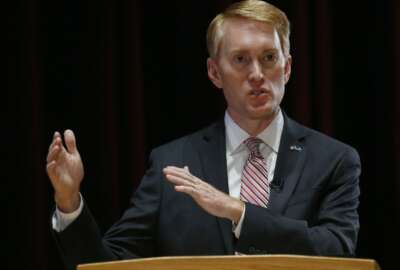
716 regulations under review by DoD
DoD’s regulatory reform task force is meeting every two weeks to finalize recommendations to meet President Trump’s executive order.
The Defense Department has 15 different regulations for the Freedom of Information Act. It has 21 assorted rules for privacy.
This is a small sample of why the White House ordered agencies in February to reduce and reform regulations with a goal of getting rid of two for every new one they write.
DoD is taking on this huge task of getting rid of regulations, some of which go back to its War Department days, by reviewing 716 rules, including 350 of which are acquisition related.
“We have a centralized task force made up of senior representatives who meet biweekly to look at regulations,” said Joo Chung, DoD’s director of oversight and compliance in the Office of the Deputy Chief Management Officer, during a presentation at the Section 809 Panel meeting in Arlington, Virginia on Aug. 22. “We’ve scheduled meetings out until 2018 to review all of these regulations on a biweekly basis so components know when they will need to brief the task force. We also tried to set up workshops before the task force briefings for components to work through the regulations. This way you are getting the subject matter expert buy-in on the recommendations. This effort does require general counsel reviews prior to when the recommendations are provided to task force for review. This is one way to be effective and ensure we as members of the task force have information we can rely on to talk about regulations at the meetings.”
Chung said expert subgroups are looking at specific areas such as acquisition, transportation and health care to review rules and make recommendations to the task force.
DoD started the task force in late April and has been looking at about 10 regulations per meeting and has sent recommendations to Secretary James Mattis for review and approval.
President Donald Trump directed agencies to establish regulatory reform task forces to start cutting red tape in February. The focus is on regulations that eliminate jobs, are “outdated or ineffective,” and those that “create a serious inconsistency or otherwise interfere with regulatory reform initiatives and policies.”
Each task force will make recommendations to repeal or simplify existing regulations.
The White House said the task forces should seek input from state and local governments, along with private sector stakeholders and businesses.
The task forces are led by a regulatory reform officer, who oversees the regulatory reform initiatives and policies.
Agencies submitted reports to the Office of Management and Budget in May detailing initial regulatory reform plans.
As of July, OMB’s Office of Information and Regulatory Affairs released a report saying agencies have withdrawn 469 proposed regulations compared to a fall 2016 report when Barack Obama was president. This includes 19 regulations with an economic impact of $100 million or more. Another 391 regulations have been delayed for further evaluation and consideration.
At DoD, the largest number of regulations under review are around acquisition.
Linda Nielson, deputy director in the Office of Defense Acquisition Regulations System for the Defense Procurement and Acquisition Policy, said the Pentagon is taking a multi-step approach to review acquisition rules.
Nielson said the first step is to do historical research on all the provisions and clauses.
“Over about two-to-three weeks, the Defense Federal Acquisition Regulations (DFARs) staff did nothing but research. Some of the provisions have been around for such a long time that we couldn’t find any evidence of their insertion into our regulations,” Nielson said at the 809 Panel meeting. “For all 350, we compiled the intended outcome of the regulations, what was the reason it was identified as an issue that required codifying. We have a copy of the description of the use and we came up with way of archiving them for every provision.”
Nielson said under Step Two, subject matter experts evaluated whether or not the provision or clause is providing benefits under the terms of the executive order.
“We went to the people who would use these things and asked whether they were providing benefits as written,” she said. “Step Two is ongoing while Step One is completed.”
She said the acquisition subgroup has held two meetings to review and recommend to the larger task force which regulations to change or get rid of.
For the first set of recommendations, Nielson said the task force agreed on nine of them, and asked the subgroup to do more research on the 10th. She wouldn’t offer more specifics about which regulations because of the pre-decisional nature of the effort.
DoD issued a Federal Register notice in June seeking comments provisions and contract clauses that may be appropriate for repeal, replacement or modification. On Aug. 1, DoD extended the comment period to Sept. 11.
Nielson said DoD has received a few comments, but expects many more to come in over the next few weeks.
One major change to the way DoD is reviewing acquisition regulations is adding a third way to measure the burden of the rules on citizens and businesses.
Nielson said the military regularly estimates the impact of regulations through Paperwork Reduction Act (PRA) and through the Small Business Regulatory Flexibility Act, but now is adding an estimate of the compliance burden.
“We will estimate the compliance burden outside of the PRA view of burden,” she said. “At this point, for the purpose of the task force, we are using information we have on hand and using OMB’s approved assessment or estimate of what PRA burden is. All of these recommendations for change will undergo rulemaking under the Office of Federal Procurement Policy Act.”
This process will not be a fast one. Nielson said it could take 18-to-24 months to go through the rulemaking process to change or terminate existing rules, while others would need congressional action because the rules are based on legislation.
She said many of these changes would come about in 2019 and 2020.
Still Nielson said DoD has confidence this process as it has done regulatory reform reviews previously over the last decade or more, but this one is different because it’s a more concentrated effort than ever before.
Copyright © 2025 Federal News Network. All rights reserved. This website is not intended for users located within the European Economic Area.
Jason Miller is executive editor of Federal News Network and directs news coverage on the people, policy and programs of the federal government.
Follow @jmillerWFED






